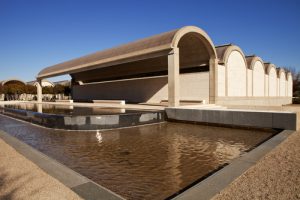Kimbell Art Museum
If you are a European art lover but residing in America, then, The Kimbell Art Museum in Forth Worth, Texas is the place for you. Giving emphasis to quality over quantity, The Kimbell is considered as one of the top small museums in the world with less than 350 works of art. However, it housed some of the most coveted works of the most celebrated artists before the 20th century, such as Rembrandt, Picasso, Michelangelo, Duccio, and Monet’s, to mention a few.
The Kimbell Art Museum’s building itself is known for its exceptional architectural design and is one of the bests in the 20th century. Louis I. Kahn, the brain behind the design, is hailed as one of the most important modern architects of his time. The combination of modern and classical architecture is apparent in his works, particularly on The Kimbell Art Museum. Until such time that they needed more space to house new artifacts. Instead of extending the same building, they built Renzo Piano Pavilion in 2013. The parking lot of the museum is located underground. 
The then Kimbell Art Foundation was established primarily by husband and wife, Kay and Velma in 1936 from their art collections. It was renamed Kimbell Art Museum as they opened it to the public in October 4, 1972.
Let your eyes feast on sculptures and paintings not only from Europe, but also from Ancient Americas, Asia, Oceanic, and Africa. These are only a few of the collections you can see at The Kimbell Art Museum.
- “Figure in a Shelter”. Henry Moore started out as a carver of wood and stone. He later tried modeling sculptures cast in bronze. It seemed that his favorite theme is shelter and protection as seen in his other works- mothers and fathers holding their children. In “Figure in a Shelter”, it shows 2 halves of a helmet ” connected to form a somewhat protection to the small structure inside, which is considered as a human body. Moore finished this awesome art three years before his death in 1986.
- “Walking Flower”. This joyous themed ceramic sculpture is a masterpiece of French artist, Fernand Léger. Spending his time during World War II in the United States, he changed his perspective and added bold colors in his work. One side of the “Walking Flower” has eye-catching colors, while the other side is white and black. it conveys the high spirit, play and humor.
- “Yombe”. This piece of art passed by different hands before it landed at The Kimbel Art Museum. It is a combination of art and history. Yombe is a wooden mask used in ancient African culture. Particularly worn by a nganga diphomba, a ritual specialist or diviner who was responsible for detecting community members who are accountable for disasters, crimes, and accidents.
- “Maori”. The name of this Oceanic artifact also pertains to a New Zealand Tribe. Carving as one of their tribe’s cultures is apparent in this statue. This is thought to be a god or a male ancestor who died of an ailment. They considered departed loved ones as “angels” that watch over their family.
- “Beauty in a White Kimono”. One of the eye-catching paintings at The Kimbell Art Museum is the hanging scroll painted by Japanese artist, Rekisentei Eiri in the 1700s. It shows a seductive courtesan wearing a white kimono with snowflakes design made through tie-dying technique. In Japan, On the eighth lunar months, courtesans of Edo (Tokyo) wore white kimonos to commemorate the day Generalissimo Tokugawa entered Tokyo, a time of internal peace and prosperity in Japan.
- “Bust of a Young Jew” Another attraction at the Kimbell Art Museum is the work Rembrandt van Rijn. He is hailed as Dutch’s greatest painter in the 17th century. His intricate use of paintbrushes sets him from the other painters. This portrait has an effect that depicts how a real photograph would look like, considering the “lighting” effect which he intelligently shown.
The Kimbell Art Museum does not have American artifacts, nor collections from the 20th century and beyond as they are displayed at the neighboring art museums, Amon Carter and Fort Worth respectively. They are true to their purpose- to bring to Americans and to all its guests, classic and unique works of art from around the globe that cannot be seen or available in other museums.

